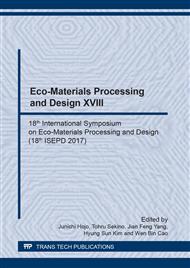p.3
p.8
p.14
p.20
p.26
p.32
p.40
p.47
p.55
Preparation and Characterization of Nanosize ZrO2 Particle for Highly Refractive Index Nanocomposite Depending on Zirconium Precursor and Concentration
Abstract:
The ZrO2 nanoparticles for highly refractive index nanocomposite are synthesized according to reaction temperature, zirconium precursor concentration, and kinds of precursor such as zirconium iso-propoxide (ZIP) and zirconium n-propoxide (ZNP). At lower reaction temperature the monoclinic phase is formed, whilst higher temperature favors the tetragonal and cubic phases. As the precursor concentration increased, the particle size of ZrO2 nanoparticle slightly increased. TEM images prove that the ZrO2 nanoparticles are spherical and monodisperse with a diameter of about 4 nm. The synthesized ZrO2 was modified methacryloxy propyltrimethoxy silane (MPS) for dispersibility in organic solvent. Fourier transform infrared spectroscopy (FT-IR) and thermogravimetric analysis (TGA) illustrate that MPS are chemically attached to the surface of the ZrO2. The ZrO2 synthesized from ZNP and ZIP dispersed in o-phenylphenoxyethyl acrylate (OPPEA) is the highly transparent and the refractive index of this nanocomposite is 1.649 and 1.670, respectively.
Info:
Periodical:
Pages:
26-31
Citation:
Online since:
May 2018
Authors:
Keywords:
Price:
Сopyright:
© 2018 Trans Tech Publications Ltd. All Rights Reserved
Share:
Citation:


